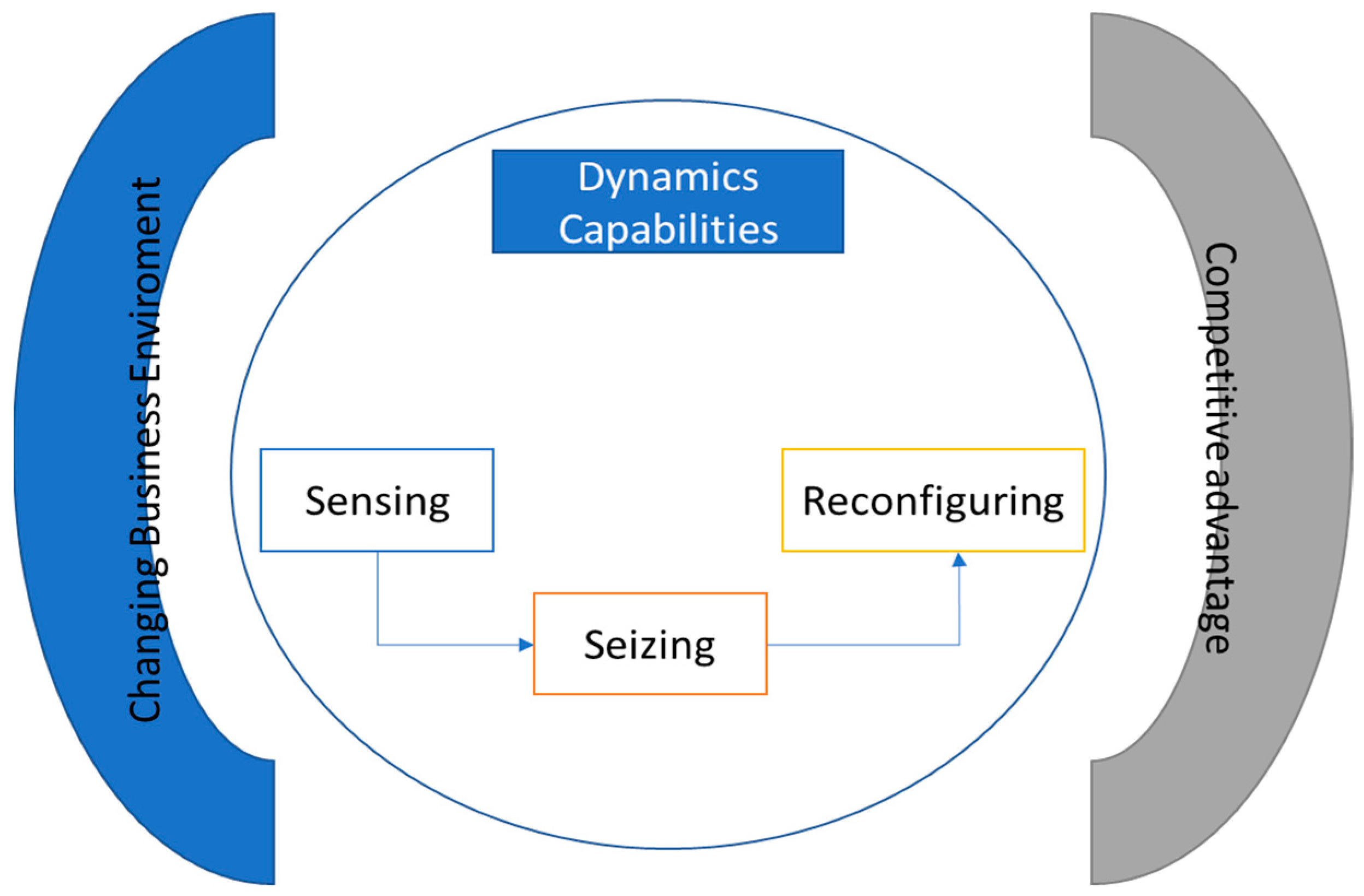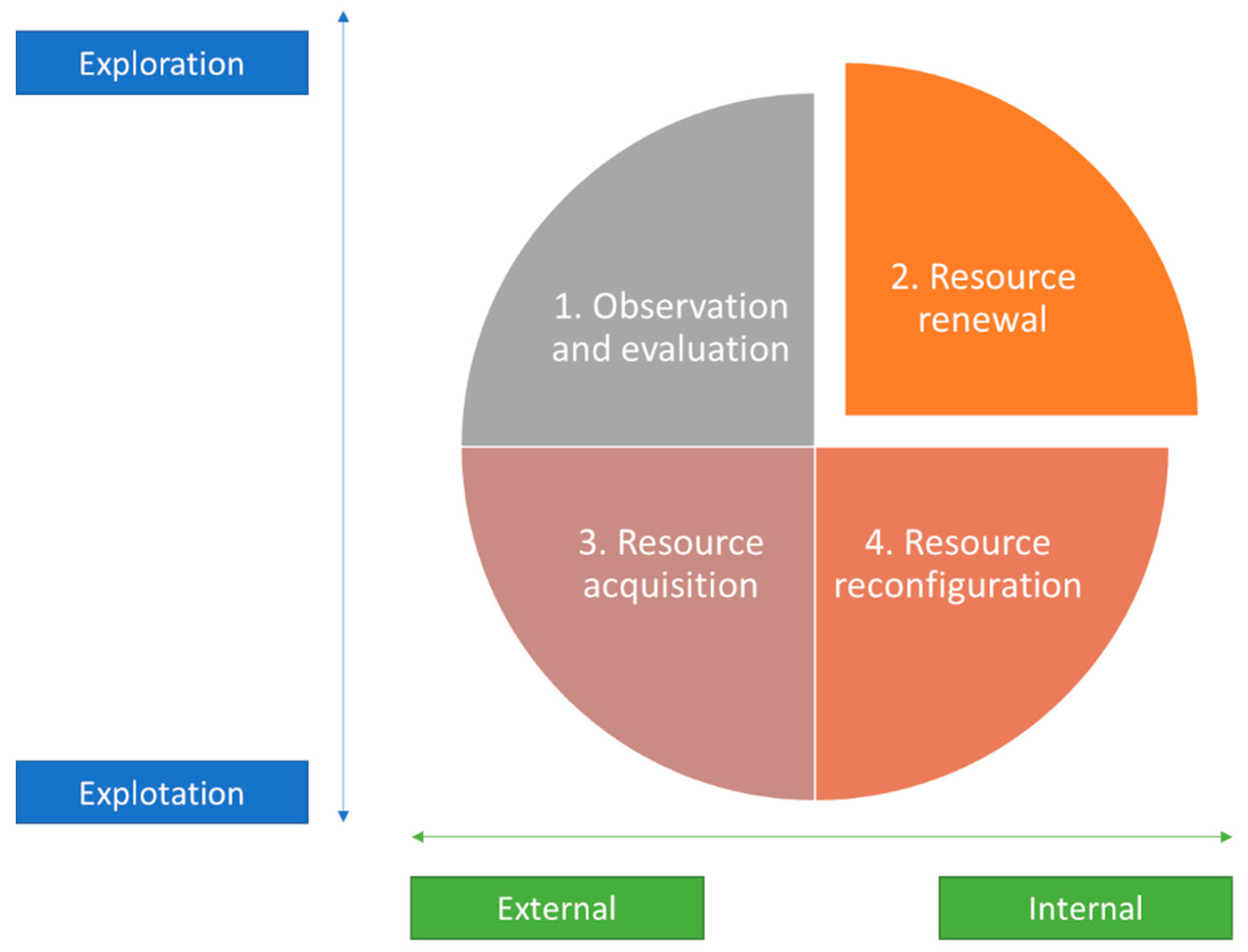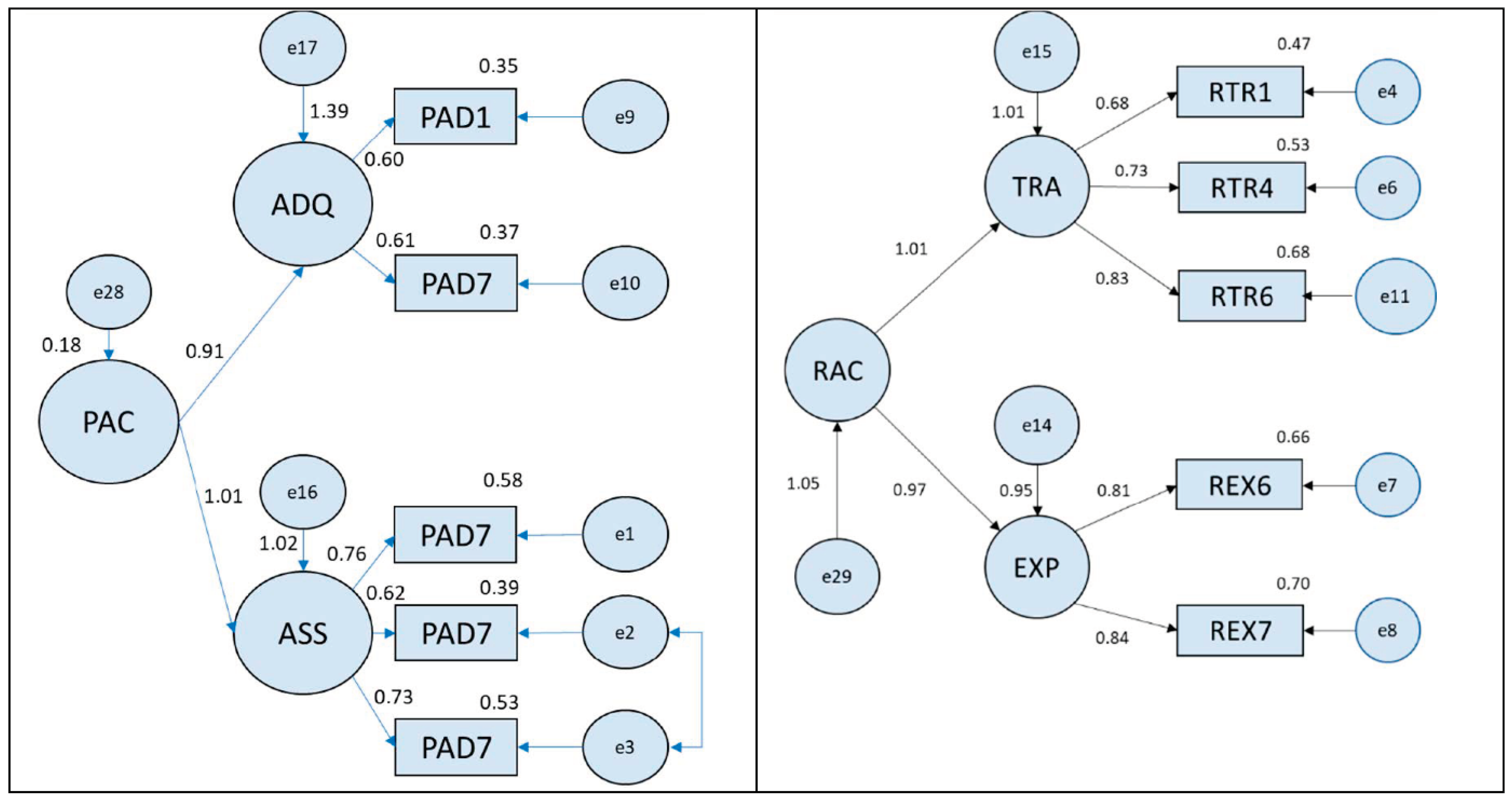Contemporary Management Practice Applying the Dynamic Absorptive Capacity Measurement Model (PM4AC) for Improved Business Sustainability
Abstract
:1. Introduction
2. Systematic Review of the Literature
2.1. Planning
2.2. Search
2.3. Selection
2.4. Quality Evaluation
2.5. Data Extraction and Synthesis of Results
3. Research Questions and Methodology
- Is it possible to determine the magnitude of the dynamic adsorption capacity in project management?
- How can the dynamic absorption capacity be measured in project management?
- First phase—Characterization and definition: In this first phase, the identification of the particularities of the organizations under study was carried out. To achieve this, surveys were applied in the organizations that are a part of the sector selected as the object of study, and the information from such surveys was considered. Available in secondary sources that offer data on the organizations, a profile containing the general characteristics of said organizations was built with this information. The characteristics that identify the organizations under study were quantitative and qualitative variables, which later became the basis for the definition of the components of the proposed model. It is expected that the components of the model are constructed from two perspectives: the first with a descriptive approach, in which the characterization variables are used to identify relationships with the absorption capacity; and the second with a predictive approach to determine the absorption capacity in project management from the variables that determine it.
- Second phase—Modeling: In this phase, the conditions and variables that affect the absorption capacity in project management were determined to carry out the integration of the variables for the construction of the measurement model of the dynamic absorption capacity in project management, as well as the definition of the relations and the scheme of operation of the same.
- Third phase—Validation: This phase allowed the model to be submitted for the consideration of the academic community through two channels: the first with the submission of preliminary research results for publication; and the second through the contrast of the results of the model with instruments that allow for the evaluation of its coherence and the validation of the model.
- Fourth phase—Documentation, analysis and discussion of results: To finalize the methodology, the results were documented, analyzed and submitted for consideration by the scientific community through the presentation of a book proposal that describes the built model. In this sense, the doctoral thesis that will be carried out in this investigation was also concluded.
Conceptualizing the Absorptive Capacity in Organizations
4. SMEs Firm Identification
5. Results
- Latent variables; the latent variables of the model are the following: dynamic absorption capacity in project management (AC), dynamic potential absorption capacity (PAC), realized dynamic absorption capacity (RAC), acquisition dimension (AQD), dimension simulation (ASS), transformation dimension (TRA) and exploitation dimension (EXP).
- Observed variables; the set of observed variables of the model is made up of: PAD1, PAD7, PAS1, PAS2, PAS10, RTR1, RTR4, RTR6, REX6 and REX7.
- Measurement errors.
- Regression coefficients.
- Variation coefficients.
6. Discussion
7. Conclusions
Author Contributions
Funding
Institutional Review Board Statement
Informed Consent Statement
Data Availability Statement
Acknowledgments
Conflicts of Interest
References
- Easterby-Smith, M.; Graca, M.; Antonacopoulou, E.; Ferdinand, J. Absorptive capacity: A process perspective. Manag. Learn. 2008, 39, 483–501. [Google Scholar] [CrossRef]
- Cohen, W.M.; Levinthal, D.A. Absorptive Capacity: A New Perspective on Learning and Innovation. Adm. Sci. Q. 1990, 35, 128–152. [Google Scholar] [CrossRef]
- Zahra, S.A.; George, G. Absorptive Capacity: A Review, Reconceptualization, and Extension. Acad. Manag. Rev. 2002, 27, 185–203. [Google Scholar] [CrossRef]
- Flatten, T.; Adams, D.; BRETTEL, M. Fostering absorptive capacity through leadership: A cross-cultural analysis. J. World Bus. 2015, 50, 519–534. [Google Scholar] [CrossRef]
- Wernerfelt, B. A Resource-Based View of the Firm. Strateg. Manag. J. 1984, 5, 171–180. [Google Scholar] [CrossRef]
- Dyer, J.H.; Singh, H. The Relational View: Cooperative Strategy and Sources of Interorganizational Competitive Advantage. Acad. Manag. Rev. 1998, 23, 660–679. [Google Scholar] [CrossRef]
- Barney, J. Firm Resources and Sustained Competitive Advantage. J. Manag. 1991, 17, 99–120. [Google Scholar] [CrossRef]
- Peteraf, M.A. The Cornerstones of Competitive Advantage: A Resource-Based View. Strateg. Manag. J. 1993, 14, 179–191. [Google Scholar] [CrossRef]
- Eisenhardt, K.M.; Martin, J.A. Dynamic Capabilities: What Are They? Strateg. Manag. J. 2000, 21, 1105–1121. [Google Scholar] [CrossRef]
- Lane, P.J.; Lubatkin, M. Relative absorptive capacity and interorganizational learning. Strateg. Manag. J. 1998, 19, 461–477. [Google Scholar] [CrossRef]
- Liao, J.; Welsch, H.; Stoica, M. Organizational absorptive capacity and responsiveness: An empirical investigation of growth–oriented SMEs. Entrep. Theory Pract. 2003, 28, 63–86. [Google Scholar] [CrossRef]
- Szulanski, G. Exploring internal stickiness: Impediments to the transfer of best practice within the firm. Strateg. Manag. J. 1996, 17, 27–43. [Google Scholar] [CrossRef]
- Kogut, B.; Zander, U. Knowledge of the firm, combinative capabilities, and the replication of technology. Organ. Sci. 1992, 3, 383–397. [Google Scholar] [CrossRef]
- Van den Bosch, F.A.J.; Volberda, H.W.; de Boer, M. Coevolution of Firm Absorptive Capacity and Knowledge Environment: Organizational Forms and Combinative Capabilities. Organ. Sci. 1999, 10, 551–568. [Google Scholar] [CrossRef]
- Fajardo Moreno, W.S. Modelo para la Medición de la Capacidad dinámica de absorción en gerencia de proyectos [Tesis de doctorado, Universidad EAN]. 2020. Available online: http://hdl.handle.net/10882/10373 (accessed on 22 May 2022).
- Biedenbach, T.; Müller, R. Absorptive, innovative and adaptive capabilities and their impact on project and project portfolio performance. Int. J. Proj. Manag. 2012, 30, 621–635. [Google Scholar] [CrossRef]
- Popaitoon, S.; Siengthai, S. The moderating effect of human resource management practices on the relationship between knowledge absorptive capacity and project performance in project-oriented companies. Int. J. Proj. Manag. 2014, 32, 908–920. [Google Scholar] [CrossRef]
- Bjorvatn, T.; Wald, A. Project complexity and team-level absorptive capacity as drivers of project management performance. Int. J. Proj. Manag. 2018, 36, 876–888. [Google Scholar] [CrossRef]
- Ash, C. Convergence of it Project Management and Change Management: A Comparative Study; CEPIS Promotes; Project Management Institute Inc.: Newtown Square, PA, USA, 2007. [Google Scholar]
- Meredith, J.R.; Shafer, S.M.; Mantel, S.J., Jr. Project Management: A Strategic Managerial Approach; John Wiley & Sons: Hoboken, NJ, USA, 2017. [Google Scholar]
- Shenhar, A.J.; Dvir, D. Reinventing Project Management: The Diamond Approach to Successful Growth and Innovation; Harvard Business Review Press: Brighton, MA, USA, 2007. [Google Scholar]
- Özkan, E.; Azizi, N.; Haass, O. Leveraging Smart Contract in Project Procurement through DLT to Gain Sustainable Competitive Advantages. Sustainability 2021, 13, 13380. [Google Scholar] [CrossRef]
- Kerzner, H. Project Management: A Systems Approach to Planning, Scheduling, and Controlling; John Wiley & Sons: Hoboken, NJ, USA, 2017. [Google Scholar]
- Wang, N.; Wei, K.; Sun, H. Whole Life Project Management Approach to Sustainability. J. Manag. Eng. 2014, 30, 246–255. [Google Scholar] [CrossRef]
- Lee, K.-W.; Kim, K.-H. Analyzing Cost and Schedule Growths of Road Construction Projects, Considering Project Characteristics. Sustainability 2021, 13, 13694. [Google Scholar] [CrossRef]
- Surco-Guillen, Y.C.; Romero, J.; Rodríguez-Rivero, R.; Ortiz-Marcos, I. Success Factors in Management of Development Projects. Sustainability 2022, 14, 780. [Google Scholar] [CrossRef]
- Killen, C.P.; Drouin, N. Project portfolio management: A dynamic capability and strategic asset. In Cambridge Handbook of Organizational Project Management; Cambridge University Press: Ataşehir, Turkey, 2017. [Google Scholar]
- Mirhosseini, A.F.; Pitera, K.; Odeck, J.; Welde, M. Sustainable Project Management: Reducing the Risk of Cost Inaccuracy Using a PLS-SEM Approach. Sustainability 2022, 14, 960. [Google Scholar] [CrossRef]
- Li, L.; Benton, W.C. Hospital technology and nurse staffing management decisions. J. Oper. Manag. 2006, 24, 676–691. [Google Scholar] [CrossRef]
- Amini, A.; Alimohammadlou, M. Toward equation structural modeling: An integration of interpretive structural modeling and structural equation modeling. J. Manag. Anal. 2021, 8, 693–714. [Google Scholar] [CrossRef]
- Ma, T.; McGroarty, F. Social Machines: How recent technological advances have aided financialisation. J. Inf. Technol. 2017, 32, 234–250. [Google Scholar] [CrossRef]
- Bornmann, L. Does the normalized citation impact of universities profit from certain properties of their published documents –such as the number of authors and the impact factor of the publishing journals? A multilevel modeling approach. J. Informetr. 2019, 13, 170–184. [Google Scholar] [CrossRef]
- Edmonds, W.A.; Kennedy, T.D. An Applied Reference Guide to Research Designs: Quantitative, Qualitative, and Mixed Methods: Quantitative, Qualitative, and Mixed Methods; SAGE Publications: Newbury Park, CA, USA, 2017. [Google Scholar]
- Helfat, C.E.; Peteraf, M.A. Managerial cognitive capabilities and the microfoundations of dynamic capabilities. Strateg. Manag. J. 2015, 36, 831–850. [Google Scholar] [CrossRef]
- Teece, D.J. Explicating dynamic capabilities: The nature and microfoundations of (sustainable) enterprise performance. Strateg. Manag. J. 2007, 28, 1319–1350. [Google Scholar] [CrossRef]
- Teece, D.J. A dynamic capabilities-based entrepreneurial theory of the multinational enterprise. J. Int. Bus. Stud. 2014, 45, 8–37. [Google Scholar] [CrossRef]
- Choi, S.; Cho, I.; Han Seung, H.; Kwak Young, H.; Chih, Y.-Y. Dynamic Capabilities of Project-Based Organization in Global Operations. J. Manag. Eng. 2018, 34, 04018027. [Google Scholar] [CrossRef]
- Madsen, E.L. A dynamic capability framework–generic types of dynamic capabilities and their relationship to entrepreneurship. In Strategic Reconfigurations: Building Dynamic Capabilities in Rapid-Innovation-Based Industries; Edward Elgar Publishing: Cheltenham, UK, 2010; pp. 223–240. [Google Scholar]
- Martínez, E.R.; García-Alandete, J.; Sellés Nohales, P.; Bernabé Valero, G.; Soucase Lozano, B. Análisis factorial confirmatorio de los principales modelos propuestos para el purpose-in-life test en una muestra de universitarios españoles. Acta Colomb. Psicol. 2012, 15, 67–76. [Google Scholar]
- Tanaka, J.S. Multifaceted conceptions of fit in structural equation models. Sage Focus Ed. 1993, 154, 10. [Google Scholar]
- Eikelenboom, M.; de Jong, G. The impact of dynamic capabilities on the sustainability performance of SMEs. J. Clean. Prod. 2019, 235, 1360–1370. [Google Scholar] [CrossRef]
- Bentler, P.M.; Bonett, D.G. Significance tests and goodness of fit in the analysis of covariance structures. Psychol. Bull. 1980, 88, 588. [Google Scholar] [CrossRef]
- Browne, M.W.; Cudeck, R. Alternative ways of assessing model fit. Sage Focus Ed. 1993, 154, 136. [Google Scholar] [CrossRef]
- Flatten, T.C.; Engelen, A.; Zahra, S.A.; Brettel, M. A measure of absorptive capacity: Scale development and validation. Eur. Manag. J. 2011, 29, 98–116. [Google Scholar] [CrossRef]
- Birollo, G.; Fajardo-Moreno, W.S. Project-Based Organizations: Project Manager Challenges at the Interface with the Customer. In Handbook of Research on Project Management Strategies and Tools for Organizational Success; IGI Global: Hershey, PA, USA, 2020; pp. 247–268. [Google Scholar]



| Potential Absorptive Capacity | ||
|---|---|---|
| Dimension | Definition | Background |
| Acquisition | A company’s ability to locate, identify, assess and acquire external knowledge that is critical to its operations. | Lane and Lubatkin [10], Zahra and George [3], Liao et al. [11] |
| Assimilation | Company capacity to absorb external knowledge. This capacity can also be defined as the processes and routines that allow new knowledge acquired to be analyzed, processed, interpreted, understood, internalized and classified. | Szulanski [12], Zahra and George [3] |
| Realized Absorptive Capacity | ||
| Transformation | Ability to develop and refine internal routines that facilitate the transfer and combination of prior knowledge with newly acquired or assimilated knowledge. | Kogut and Zander [13], Van den Bosch, Volberda, and de Boer [14] |
| Exploitation | Organizational capacity that allows companies to incorporate, assimilate and transform the knowledge acquired into their operations and routines. | Lane and Lubatkin [10], Zahra and George [3] |
| Key Terms | 7 | Boolean Operators | OR AND LIMIT TO | Date Range | 2010 to 2019 |
|---|---|---|---|---|---|
| (TITLE-ABS-KEY (“Absorptive Capacity”) AND TITLE-ABS-KEY (“Project Management”) OR TITLE-ABS-KEY (“project management”) OR TITLE-ABS-KEY (“absorptive capacity”) OR TITLE-ABS-KEY (“Absorptive capacity”) AND TITLE-ABS-KEY (measurement) OR TITLE-ABS-KEY (measurement)) AND (LIMIT-TO (SUBJAREA, “BUSI”) OR LIMIT-TO (SUBJAREA, “SOCI”) OR LIMIT-TO (SUBJAREA, “ENGI”) OR LIMIT-TO (SUBJAREA, “COMP”) OR LIMIT-TO (SUBJAREA, “DECI”) OR LIMIT-TO (SUBJAREA, “ECON”) OR LIMIT-TO (SUBJAREA, “ENVI”) OR EXCLUDE (SUBJAREA, “MEDI”) OR EXCLUDE (SUBJAREA, “BIOC”) OR EXCLUDE (SUBJAREA, “CENG”) OR EXCLUDE (SUBJAREA, “MATE”) OR EXCLUDE (SUBJAREA, “EART”)) AND (LIMIT-TO (PUBYEAR, 2019) OR LIMIT-TO (PUBYEAR, 2018) OR LIMIT-TO (PUBYEAR, 2017) OR LIMIT-TO (PUBYEAR, 2016) OR LIMIT-TO (PUBYEAR, 2015) OR LIMIT-TO (PUBYEAR, 2014) OR LIMIT-TO (PUBYEAR, 2013) OR LIMIT-TO (PUBYEAR, 2012) OR LIMIT-TO (PUBYEAR, 2011) OR LIMIT-TO (PUBYEAR, 2010)) | |||||
| Phase | Search | Reference Author’s Analysis | Selection | Evaluation |
|---|---|---|---|---|
| Documents | 59 | 273 | 146 | 82 |
| Acquisition | Assimilation | Transformation | Exploitation | ||||
|---|---|---|---|---|---|---|---|
| Factor 1 | Factor 1 | Factor 1 | Factor 1 | ||||
| PAD2 | 0.787 | PAS10 | 0.854 | RTR6 | 0.843 | REX7 | 0.799 |
| PAD6 | 0.761 | PAS9 | 0.832 | RTR7 | 0.810 | REX6 | 0.791 |
| PAD8 | 0.755 | PAS2 | 0.795 | RTR2 | 0.742 | REX5 | 0.696 |
| PAD5 | 0.733 | PAS11 | 0.791 | RTR4 | 0.739 | REX1 | 0.642 |
| PAD7 | 0.732 | PAS8 | 0.773 | RTR3 | 0.706 | REX2 | 0.636 |
| PAD3 | 0.731 | PAS3 | 0.756 | RTR1 | 0.695 | REX4 | 0.631 |
| PAD1 | 0.660 | PAS6 | 0.742 | RTR5 | 0.666 | REX3 | 0.523 |
| PAD4 | 0.656 | PAS7 | 0.703 | ||||
| PAS14 | 0.685 | ||||||
| PAS5 | 0.670 | ||||||
| PAS4 | 0.663 | ||||||
| PAS12 | 0.659 | ||||||
| PAS1 | 0.651 | ||||||
| PAS13 | 0.532 | ||||||
| Dimension | Interview Outcome | Alignment with the Measure of PM4AC is Presented? |
|---|---|---|
| Acquisition | The information gathered in the interviews allowed us to see that the descriptions of the practices implemented by the organization corresponded to the assimilation dimension, with respondents saying they were at a high level. | Yes |
| Assimilation | The socialization of lessons mentioned by respondents represents practices that enable knowledge management in organizations; these types of actions represent mechanisms for the assimilation dimension. Respondents classified it as high. | Yes |
| Transformation | Kaizen outcomes are expressions of how an organization uses its social relationships to improve the commercialization benefits of products or services resulting from the projects it implements. This is a typical assimilation dimension. Respondents rated this level as high. | Yes |
| Exploitation | Demonstrating the experience of a successful project to clients is part of the routine of developing a project that leads to a new product or service, an act defined in the development dimension. Respondents rated this performance as high. | Yes |
| Potential and realized absorptive capacity | Estimated commercial application of new knowledge in the organization is between 80% and 90% and must be classified as high. | Yes |
| Absorptive capacity | Respondents mentioned incidents that responded to the definition of acceptance in project management when the service of knowledge acquired through the organization referred to business applications. | Yes |
| Model Fit Measurement | Outcome | Interpretation |
|---|---|---|
| Normed fit index (NFI) | 0.935 | This metric assesses the decline in the hypothetical model’s χ2 statistic relative to the base model [40]. According to the results obtained, the minimum value of 0.90 is exceeded. |
| Comparative fit index (CFI) | 0.986 | This metric is one of the relative indicators of increased usage and behavior [41]. It also varies between 0 and 1: a value of 0.9 is the minimum required to protect the model [42,43]. The obtained results are implemented for the proposed model. |
| RMSEA | 0.042 | This is a measure of the size of the model error and is an indicator of a good fit, with values less than 0.05 [41]. This is achieved in the proposed model with a result of 0.042. |
Publisher’s Note: MDPI stays neutral with regard to jurisdictional claims in published maps and institutional affiliations. |
© 2022 by the authors. Licensee MDPI, Basel, Switzerland. This article is an open access article distributed under the terms and conditions of the Creative Commons Attribution (CC BY) license (https://creativecommons.org/licenses/by/4.0/).
Share and Cite
Acosta-Velásquez, R.D.; León-Pulido, J.; García-Pérez, A.; Fajardo-Moreno, W.S.; Espinosa-Leal, L. Contemporary Management Practice Applying the Dynamic Absorptive Capacity Measurement Model (PM4AC) for Improved Business Sustainability. Sustainability 2022, 14, 11036. https://doi.org/10.3390/su141711036
Acosta-Velásquez RD, León-Pulido J, García-Pérez A, Fajardo-Moreno WS, Espinosa-Leal L. Contemporary Management Practice Applying the Dynamic Absorptive Capacity Measurement Model (PM4AC) for Improved Business Sustainability. Sustainability. 2022; 14(17):11036. https://doi.org/10.3390/su141711036
Chicago/Turabian StyleAcosta-Velásquez, Rubén Dario, Jeffrey León-Pulido, Alexander García-Pérez, William Stive Fajardo-Moreno, and Leonardo Espinosa-Leal. 2022. "Contemporary Management Practice Applying the Dynamic Absorptive Capacity Measurement Model (PM4AC) for Improved Business Sustainability" Sustainability 14, no. 17: 11036. https://doi.org/10.3390/su141711036
APA StyleAcosta-Velásquez, R. D., León-Pulido, J., García-Pérez, A., Fajardo-Moreno, W. S., & Espinosa-Leal, L. (2022). Contemporary Management Practice Applying the Dynamic Absorptive Capacity Measurement Model (PM4AC) for Improved Business Sustainability. Sustainability, 14(17), 11036. https://doi.org/10.3390/su141711036







